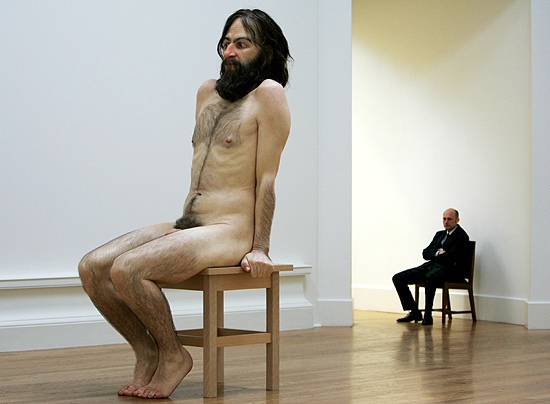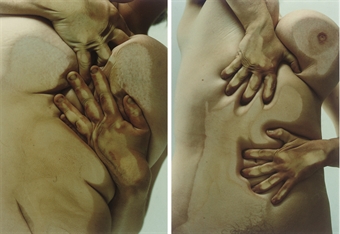I consider myself very fortunate to have caught the final days of the
National Gallery of Victoria's exhibition of
Ron Mueck just as The Great Relocation For Research drew me southward at the beginning of 2010.
 |
| Ron Mueck. Dead Dad (1997), detail. Pregnant Woman (2002). |
Having come across Pregnant Woman many years ago in the National
Gallery of Australia in Canberra, I immediately became a convert and
was particularly struck by the weight of the piece - this was a woman caught in a single moment of silent stillness. Weighed down by her heavily pregnant belly, her feet braced stolidly apart to support her changing form, she exudes a quiet weariness. Onlookers can observe the translucency of her skin, the blue veins and stretch marks and slight blush on her cheeks, the bead of moisture on her lips and fine lines around her eyes. The realism is uncanny. At over 2.5 metres tall she stands solitary and frozen, the enormous weight made visible as she focuses herself inward.
This embodies the powerful formula behind Mueck's work - startling moments of personal intimacy and vulnerability are captured in time as the hyper-realism of the pieces is offset by their alarming detail. Rendered in the miniature or at a gigantic scale the moment is both lain bare and concentrated as the narrative is contained by halted time.
Of the exhibition, the NGV writes on its site:
"Mueck’s sculptures are some of the most widely acclaimed, prominent and
identifiable works in the international contemporary art arena. Often
naked and suspended in states of self-consciousness, introspection or
deep contemplation, his figures present both emotional and physical
states of exposure.
As viewers we experience a level of unease
that is borne of a voyeuristic awkwardness, as though we have invaded
some kind of personal space. However, we also identify with the human
condition these poignant moments express.
Astounding in their
apparent realism and compelling in their ability to invite interaction
Ron Mueck’s works have earned him a singular place as the creator of
some of the most evocative sculptures of our time.
This is the most comprehensive exhibition of work by the
Australian-born, London-based artist to have been presented in the
southern hemisphere. It includes four new works by Mueck in addition to
some of his major, recognised works including the iconic Dead Dad 1996/97."
 |
| Mask (1997) |
 |
| Dead Dad (1997)
|
Dead Dad was commissioned along with two other sculptures (Angel and Mask) by influential art collector Charles Saatchi for the Young British Artists show Sensation in 1997. The piece is tiny, a mere 1.2m long. His skin is rendered wan and pasty in death, greying and spotted with light stubble as he lies limp and exposed on the floors of galleries across the world.
The vulnerability of the piece is heart wrenching and in stark contrast to Mask, which at almost 1.5m tall is confrontational, gigantic - and frankly terrifying - with its direct, belligerent gaze. Yet the experience of rounding the corner and discovering the featureless shell that is the back of this very solid looking face is by far the most unsettling aspect of the work. This piece, and the similarly monumental Mask II (2002) bring the illusion of the realist form and emotional narrative embedded in these skin surfaces
tumbling down when seen from a revelatory angle.
 |
| Wild Man (2005) |
The experience of touching the provided material samples in the NGV exhibition is also a revelatory experience. Revealing what the respectful distance of a gallery environment does not, the tactility of the sculptures is exposed as cold, hard, and very solid. Made from resins, silicone, polyurethane, fibreglass, aluminium and steel armatures, and synthetic hair fibres these pieces are a tribute to the power of representation and illusion.
In pieces like Woman with Sticks, Wild Man, Spooning Couple and Two Women the skins of the subjects are inscribed with their immediate experiences. The Woman with Sticks has roughened hands from her ongoing hard labour and pinkening scratches from the branches she struggles to carry criss cross her arms. Wild Man (my favourite Mueck piece) has pimples on his back, oversized pores on his nose, sunspots, overgrown hair, callouses on his toes, fragments of dirt under his nails, and has raised veins as he grips his oversized chair in terror. Already a contextually powerful piece (the
crowds of gallery going onlookers clustered in intense scrutiny could be the source of his discomfort), these markings signify his life that has taken place away from culturally established standards of personal presentation.
Spooning Couple consists of a small scale man and woman in the midst of sleep, skins subtly charged with the differences of gender - hers pillowy, soft, dappled, and loosened at the stomach (has she had a child?), his tauter with the implied underlying structure of a male physique with less fat. The Two Women are wizened, softly paunched, delicately wrinkled, and expression lined with the years preceding their current age.
These are examples of the highly emotive, richly detailed works that Mueck has perfected. His sculptures have been elevated to a level of hyper-reality that leaves observers with an uncanny sense of connection and wonder at the minute detail captured at these different scales. Particularly, the nuanced role that skin has in communicating our histories and present experiences.
 |
| Two Women (2005) |
 |
| Spooning Couple (2005) |

































